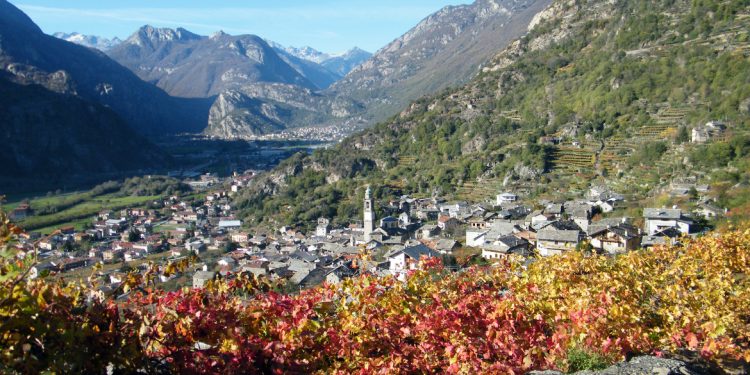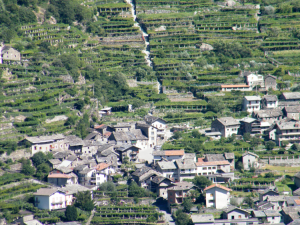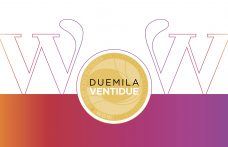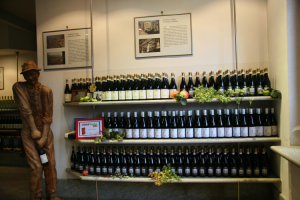
Carema wine, Barolo from the mountains

By Cesare Pillon
As a great Nebbiolo from northern Piedmont, Carema has only one fault: in good years only 55 thousand bottles are produced. It is not well-known, and neither is the village it gets its name from: Carema, the last municipality in the upper Canavese area, bordering Valle d’Aosta, with only 750 inhabitants. Drivers glance at it absent-mindedly from the other bank of the Dora Baltea river as they speed along the motorway to go skiing. If they paid a bit more attention, perhaps they would get, like the author and film director Mario Soldati about sixty years ago, “that same violent and unrepeatable feeling that we got when we arrived in Venice for the first time, when we saw the first skyscrapers in New York and when we went down to the first Paris métro.”
Why Carema wine is so particoular
But what is so special about Carema? It has vineyards on terraced land at an altitude of 300 to 600 metres on the steep slope of a mountain: high ground where the earth was brought up by hand in conical wicker baskets and where the vine is pergola-trained (called topia in the local Piedmontese dialect). It is certainly not the only example of extreme viticulture in Italy, but only in Carema are the pergolas supported by hundreds of little truncated-cone-shaped columns built using stones wrenched from the mountainside, which reshape the natural landscape and transform it into a real masterpiece of breath-takingly beautiful spontaneous architecture.
A famous architectural historian, Augusto Cavallari Murat, wrote, “Those pillars on hanging terraces are akin to the continual loggias and blind archlets of Romanesque and Gothic churches.” The presence of vineyards was already documented in the area about two thousand years ago, at the time of the Roman Emperor Augustus, whereas a famous letter by Pope Paul III’s wine steward, Sante Lancerio, to Cardinal Guido Ascanio Sforza and the De naturali vinorum historia by Andrea Bacci bear witness to the fact that already in the sixteenth century, Carema (at that time known as “Ivrea wine”) was already considered a very high-quality red wine. It reached the peak of its success at the end of the nineteenth century, when the production area increased to include another five municipalities, Settimo Vittone, Cesnola, Pont-Saint-Martin, Perloz and Donnas, covering 351 hectares of vineyards, that today would enable them to produce almost 3 million bottles.
A dramatic succession of tragic events put an end to that expansion: firstly the spread of powdery mildew, which compromised several harvests, then the First World War, which took men and resources away from an area that was already overstretched; the good exposure and constant ventilation saved the area from the disaster of downy mildew, but not from phylloxera, which arrived late, at the end of the 1920s, but with an even more devastating effect in an area already under stress; and to close the circle the Second World War, preventing the movement of goods not for used for the war effort for five years, and limiting the consumption of this Barolo from the mountains within the confines of the Canavese and Biella areas. And yet on 9th July 1967 Carema was one of first wines from Piedmont to attain Controlled Designation of Origin status. The DOC, however, was only attributed to the municipality of Carema: Pont-Saint-Martin, Perloz and Donnas had become part of the newly-created region of Valle d’Aosta, while Cesnola and Settimo Vittone were excluded because only 75% of the vines in their vineyards were Nebbiolo.
After phylloxera, only Picounter and Pûgnet
In Carema, however, the renewal of vineyards destroyed by phylloxera was carried out by maintaining only two native Nebbiolo clones, Picoutener and Pûgnet, also thanks to the strictness with which the two local nurserymen (two brothers, Achille and Emilio Fabiole Nicoletto) had worked. The vicissitudes of the first half of the twentieth century had reduced the number of hectares cultivated with vines from 122 in 1909 to 44, but registration to the DOC was only requested for 38 of them: most likely out of diffidence or fear of having to pay a tax. There appears to be about 130 vinegrowers working in Carema at that time, but since their vineyards were on average 0.33 hectares each, in reality they were only part-time vinegrowers, working in the local industries; some at the Ilssa-Viola steelworks in Pont-Saint-Martin, many at Olivetti. Three wineries took advantage of the DOC for selling their wines: two private ones, Ferrando and Morbelli, and a cooperative, the Cantina dei Produttori Nebbiolo di Carema (Nebbiolo Producers’ Winery in Carema), counting 29 members at that time. This last winery was set up under the protection of the Community Movement, which Adriano Olivetti had founded with the aim of creating harmonious integration between his factory and the land and its activity.
The idea of a winery for ageing the members’ wines together came from the fact that Carema, like all Nebbiolo wines, is astringent and needs to age very slowly in wood, but with such tiny vineyards the vinegrowers found it hard to fill a barrel each. Therefore the idea was spot on, but the mistake was for it to be sponsored by a movement opposed by almost all of the political forces of the time, which is why the Agricultural Inspectorate in Turin refused to finance the project and the 29 members had to build the cellar themselves, using their own money and labour. It was the council, however, that made Carema take that exciting leap in quality, by fulfilling one of Luigi Veronelli’s thousands of ideas; he had suggested many times create structures able to give small vinegrowers technical assistance with the same spirit as the village doctor.
The Carema production rules
The possibility of creating a local wine consultancy in Carema (where there were only enough hectares to make one winery prosper, whereas there were actually 130 owners, none of which could afford a consultant) materialized due to three factors: the initiative of the Councillor for Agriculture, Gianni Fabiole Nicoletto, the generous helpfulness of the wine technician Gaspare Buscemi and the interest of a very sensitive and experienced wine merchant from Milan, Luigi Gaviglio, who offered this undertaking a commercial outlet. The enterprise, the only one of its kind in Italy, was set up between 1980 and 1985: Fabiole based council intervention at the Producers’ Winery, where Buscemi met the vinegrowers and analysed their wines in a purpose-built laboratory, showing them how to improve them.
The experience of the Consultancy, introduced by Veronelli, led to Carema di Carema, the flagship wine of the Producers’ Winery until the advent of Carema Riserva, introduced in 1998 by modifying the production rules. Despite such an intense past, today Carema has reached a turning point: the number of vinegrowers has remained more or less the same, but their average age has increased: according to a study carried out in 2006, none were below the age of thirty and 10% were over 75; considering a production potential of over 700 thousand bottles if all of the 122 hectares of vineyards of the past were cultivated, the average production of the two wineries, Ferrando and the Nebbiolo Producers’ Winery, has only been 42 thousand bottles in recent years. In fact the area cultivated with vineyards is less than 16 hectares: the higher terraces, abandoned by vinegrowers, have been reclaimed by woods and new generations are no longer prepared to break their back for viticulture that doesn’t repay such effort. There are some who intend to replant the vines, but using the espalier training system: it costs four times less. It might make no difference to the wine, but it would certainly alter the landscape – and not for the better. A popular idea is to rebuild the pergolas on the edge of the terraces and to plant the rows behind them, in the hidden part. In the meantime, to prevent the situation from degenerating, a Slow Food Presidium has been set up, with a card saying “By buying this bottle you are helping to maintain a unique landscape and to sustain a heroic form of viticulture”.
Ferrando
The Ferrando family has worked in wine for five generations. In 1890 the head of the family, Giuseppe Ferrando, moved from Acqui to Ivrea with the aim of introducing Piedmontese wines to the Valle d’Aosta. That business became a winery in 1902: it was created by his son, Luigi, in the former San Bernardino convent, in the rooms underneath the residence of the engineer Camillo Olivetti. The turning point came in 1957 when the founder’s grandson, Giuseppe, decided to no longer just sell bottles, but also started to produce them, debuting with Nebbiolo di Carema. His son Luigi built the cellar in the municipality in 1964, and it was due to his initiative that Carema became well-known all over the world, with exports to England, Germany, Holland, Switzerland, United States, Canada, Australia and even Japan. At the head of the winery today is his son Roberto, who, with the help of winemaker Mario Ronco, vinifies the grapes of two hectares of vineyards (almost one hectare is owned), which he uses to produce about ten thousand bottles a year of two types of wine: the Etichetta Nera (Black Label) and the Etichetta Bianca (White Label). In 1995, they began ageing the former, a finer wine, in barriques.
Nebbiolo Producers’ Winery in Carema
It was set up on 30th November 1960 as a limited cooperative company with ten members, who had become 29 by 1967, when the winery was actually built. This Winery deliberately avoided calling itself a cooperative winery, because in the collective imagination of the time it was synonymous with low-quality, bulk wine. But there was another unusual feature of this winery: it was set up only to manage the ageing and maturation of wines, because the members wanted to process the grapes from their own vines themselves. It was only in 1984 that they decided to hand over the grapes instead of the finished wine, thus making great savings in manual labour and chemical analysis costs (and also improving the product, vinified under the control of a winemaker). There are currently 95 vinegrowers belonging to the Winery: Viviano Gassino is the president and Luciano Clerin is honorary president, as well as the historical memory of the Winery. The DOC vineyards owned by the members cover 13 hectares and produce 30 thousand bottles of Carema Classico and 15 thousand of Carema Riserva every year, with the help of an agrotechnician, Carlo Bersani, and a winemaker, Maurizio Forgia.
From Italian Wine Chronicle 1/2015. Read for free the magazine
See also ...



Alto Adige meets Alsace at the home of Gewürztraminer
Gewürztraminer in Alto Adige and Alsace: a focus on the differences in terroir, Read more


